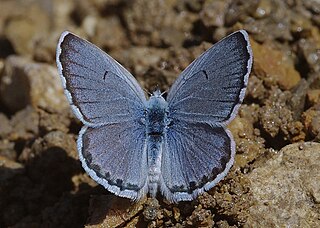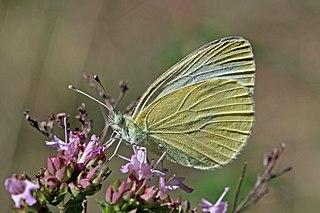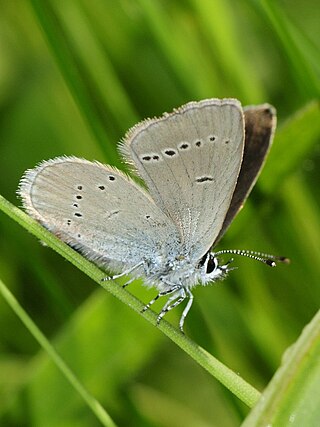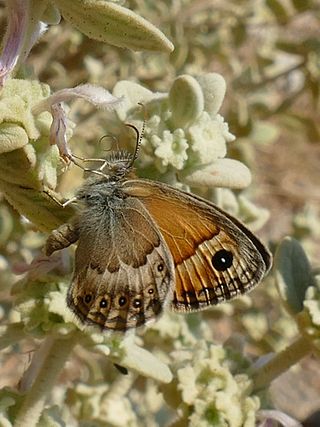
Cyaniris semiargus, the Mazarine blue, is a Palearctic butterfly in the family Lycaenidae.

Pseudophilotes vicrama, the eastern baton blue, is a small butterfly found in Asia, east to Tian Shan and parts of China, west to the Balkans, Turkey, eastern Europe to southern Finland. It belongs to the lycaenids or blues family. The species was first described by Frederic Moore in 1865.

Polyommatus eros, the Eros blue or common meadow blue, is a species of blue butterfly found in the Palearctic.

Boloria titania, the Titania's fritillary or purple bog fritillary, is a butterfly of the subfamily Heliconiinae of the family Nymphalidae.

Glaucopsyche alexis, the green-underside blue, is a butterfly of the family Lycaenidae. It is found in the Palearctic.

Leptotes pirithous, commonly known as Lang's short-tailed blue or common zebra blue, is a butterfly of the family Lycaenidae.

Pseudophilotes baton, the baton blue, is a butterfly of the family Lycaenidae. It is found in central and southern Europe and then east across the Palearctic to the Russian Far East.

Polyommatus damon, the Damon blue, is a butterfly of the family Lycaenidae.

Polyommatus daphnis, the Meleager's blue, is a butterfly of the family Lycaenidae.

Polyommatus escheri, Escher's blue, is a butterfly of the family Lycaenidae. It is found in Southern Europe and Morocco.

Muschampia tessellum, the tessellated skipper, is a butterfly of the family Hesperiidae. It is found from the southern Balkan Peninsula through Ukraine, southern Russia and Asia Minor, southern Siberia, Mongolia, east to the Amur region.

Pieris ergane, the mountain small white, is a butterfly of the family Pieridae. It is found in Southern Europe, Asia Minor, Syria, Iraq, Iran and Transcaucasia.

Ripart's anomalous blue is a butterfly in the family Lycaenidae.

Polyommatus (Plebicula) dorylas, the turquoise blue, is a butterfly of the family Lycaenidae. It is found in southern Europe, Asia Minor, the Ural Mountains, Caucasus and Transcaucasia. Its wingspan is 15–17 mm. The butterfly's common name comes from the dazzling bright blue colour of male's wings. The larvae feed on Anthyllis vulneraria. The butterfly flies from May to September in two generations. Habitats include flowery meadows in rocky areas at 500–2000 m.

The Osiris blue is a butterfly in the family Lycaenidae. It is found in South Europe, Asia Minor, southern Siberia, the Alay Mountains, Tian-Shan, Dzhungarsky Alatau, the Altai Region, the Sayan Mountains, Lake Baikal and Mongolia. It is often confused with the small blue, a closely related species.

The twin-spot fritillary is a butterfly in the family Nymphalidae.

Aricia anteros, the blue argus, is a European butterfly in the family Lycaenidae. It has a wingspan of 30–34 mm. In Europe it can be found in Macedonia, Albania, Greece, Bulgaria, Serbia, Croatia, Montenegro, Bosnia and Herzegovina, Romania, Ukraine and in Turkey. Its primary larval food plants are Geranium sanguineum and Geranium macrorrhizum.

Coenonympha thyrsis is a small butterfly found in the Palearctic that belongs to the browns family. It is endemic to Crete.

Kretania eurypilus, the eastern brown argus, is a butterfly found in the East Palearctic that belongs to the family Lycaenidae.

Polyommatus damone is a Palearctic butterfly in the Lycaenidae family.




















